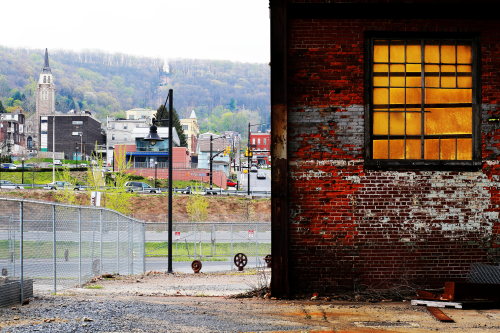The future of America’s economy lies in its high-tech innovation sector, but it is now clear that same sector is widening the nation’s regional divides—a fact that became starkly apparent with the 2016 presidential election.
Based on “winner-take-most” network economies, the innovation sector has generated significant technology gains and wealth but has also helped spawn a growing gap between the nation’s dynamic “superstar” metropolitan areas and most everywhere else.
Neither market forces nor bottom-up economic development efforts have closed this gap, nor are they likely to. Instead, these deeply seated dynamics appear ready to exacerbate the current divides.
Which is why the nation requires a major push to counter these dynamics. Specifically, the nation needs—as one initiative among others—a massive federal effort to transform a short list of “heartland” metro areas into self-sustaining “growth centers” that will benefit entire regions.
To that end, the present paper proposes that Congress assemble and award to a select set of metropolitan areas a major package of federal innovation inputs and supports that would accelerate their innovation-sector scale-up. Along these lines, we envision Congress establishing a rigorous competitive process by which the most promising eight to 10 potential growth centers would receive substantial financial and regulatory support for 10 years to become self-sustaining new innovation centers. Such an initiative would not only bring significant economic opportunity to more parts of the nation, but also boost U.S. competitiveness on the global stage.
The problem
Rather than growing together, the nation’s regions, metropolitan areas, and towns have been growing apart. That has been a shock for mainstream economists and policymakers who have long trusted the self-regulating nature of the regional economics market. And indeed, for much of the 20th century, market forces had tended toward “convergence” among communities—reducing wage, investment, and business formation disparities between more- and less-developed regions.

However, that trend began to break down in the 1980s, as digital technologies and innovation moved to the center of economic activity. Intense new demands for talent and insights increased the value of “agglomeration” economies, unleashing self-reinforcing dynamics that increasingly benefited big, coastal regions, often to the detriment of cities and metro areas in other parts of the nation.
Amid these conditions, convergence gave way to “divergence.” A top tier of tech- and innovation-heavy metro areas such as Boston, San Francisco-San Jose, and Seattle began to consistently outperform less-tech-based places on measures of innovation-driven prosperity.
The result is a crisis of regional imbalance.
Findings and recommendations
Assuming that nonchalance is no longer tenable, the present report posits that the time has come for the nation to offset the pull-away of the innovation superstars with a concerted intervention to support the emergence of new tech stars in new places. As such, the report draws a number of conclusions and recommendations in the process of laying out what a federal innovation-based growth centers program might look like, including the following:
- Regional divergence has reached extreme levels in the U.S. innovation sector. The innovation sector—composed of 13 of the nation’s highest-tech, highest R&D “advanced industries—contributes inordinately to regional and U.S. prosperity, and its diffusion into new places would greatly benefit the nation’s well-being. However, the sector has instead been concentrating in a short list of superstar metropolitan areas. Most notably, just five top innovation metro areas—Boston, San Francisco, San Jose, Seattle, and San Diego—accounted for more than 90% of the nation’s innovation-sector growth during the years 2005 to 2017. As such, they have increased their share of the nation’s total innovation employment from 17.6% to 22.8%. In contrast, the bottom 90% of metro areas (343 of them) lost share. As a result, fully one-third of the nation’s innovation jobs now reside in just 16 counties, and more than half are concentrated in 41 counties.


- Such high levels of territorial polarization are a grave national problem. At the economic end of the equation, the costs of excessive tech concentration are creating serious negative externalities. These range from spiraling home prices and traffic gridlock in the superstar hubs to a problematic “sorting” of workers, with college-educated workers clustering in the star cities, leaving other metro areas to make do with thinner talent reservoirs. As a result, whole portions of the nation may now be falling into “traps” of underdevelopment—and that is creating baleful social impacts. Many Americans now reside far from the opportunities associated with the nation’s innovation centers, undercutting economic inclusion and raising social justice issues. Regional divergence is also clearly driving “backlash” political dynamics that are exacerbating the nation’s policy stalemates.

- Markets alone won’t solve the problem—“place-based” interventions will be essential. When the economy was “converging,” it was easy to assume that any problems of regional unevenness would naturally resolve themselves. However, the rise of newer, innovation-oriented economic theories has given more attention to the power of local “agglomeration” effects, by which large benefits accrue to firms when they locate together in urban areas. In that context, “bottom-up” economic development efforts likely will not change these patterns by themselves, in part because the resources states and cities can bring to bear are limited. Accordingly, the U.S. needs not just nation-scaled solutions for its regional imbalances but place-based ones as well.
- The nation should counter regional divergence by creating eight to 10 new regional “growth centers” across the heartland. The time is right for, among other initiatives, a 21st century update of “growth pole” strategy—the 1960s and 1970s emphasis in regional economic planning that called for focusing transformative investment on a limited number of locations to catalyze the takeoff of those regions and the nation.
Along these lines, the federal government should:
- Assemble a major package of federal innovation inputs and supports for innovation-sector scale-up in metropolitan areas distant from existing tech hubs. Central to this package will be a direct R&D funding surge worth up to $700 million a year in each metro area for 10 years. Beyond that will be significant inputs such as workforce development funding, tax and regulatory benefits, business financing, economic inclusion, urban placemaking, and federal land and infrastructure supports.
A rough estimate of the price of such a program suggests that a growth centers surge focused on 10 metro areas would cost the federal government on the order of $100 billion over 10 years. That is substantially less than the 10-year cost of U.S. fossil fuel subsidies.
- Establish a competitive, fair, and rigorous process for selecting the most promising potential growth centers to receive the federal investment. A new growth center program would select for awards the eight to 10 metropolitan areas that had best demonstrated their readiness to become a new heartland growth center. The process would employ a rigorous competition characterized by an RFP-driven challenge, goal-driven criteria, and an independent selection process.
- Numerous metropolitan areas in most regions have the potential to become one of America’s next dynamic innovation centers. Based on a demonstration in this report, some 35 metro areas surface as possibilities for growth center designation. Candidates are situated in at least 19 states, lie in multiple regions (especially the Great Lakes, Upper South, and Intermountain West), and often exist at far remove from the coastal superstars. There are likely many more “up-and-coming” metro areas that have a solid capacity to bring tech-based development closer to the nation’s left-behind places.

To be sure, there will be objections. Some will say the present proposal goes way too far, while others will say it doesn’t go far enough.
Many conventional economists will argue that any push to promote regional equity will come at the expense of efficiency. However, the negative externalities of the current imbalances and the positive ones of catalyzing new growth in new places each suggest that intervention can benefit the nation’s total welfare and global competitiveness. Other critics will deny the ability of the federal government to effectively pick regional “winners” or reject that the emergence of existing clusters had anything to do with government efforts. But one has only to examine the history of U.S. technology hubs such as Boston, the Bay Area, and North Carolina’s Research Triangle to see that the federal government has often played important, if not decisive, roles in helping new tech centers attain critical mass.
To the other point, others may say that a growth centers push does not sufficiently “change capitalism” or address the full crisis of America’s smaller cities, towns, and rural areas. That is true—there is much more that needs doing, especially for the most deeply struggling communities. But the proposed innovation surge would absolutely begin to transform the nation’s spatial malaise. Most notably, it would bring new vitality closer to more communities, allowing for smaller towns and counties to benefit through supply chain relationships, commuting, and other interdependencies with the growth centers.
In that spirit, then, the present initiative is best viewed as but one component of the full federal agenda needed to ameliorate the nation’s unbalanced economic geography.
America should launch this experiment.









